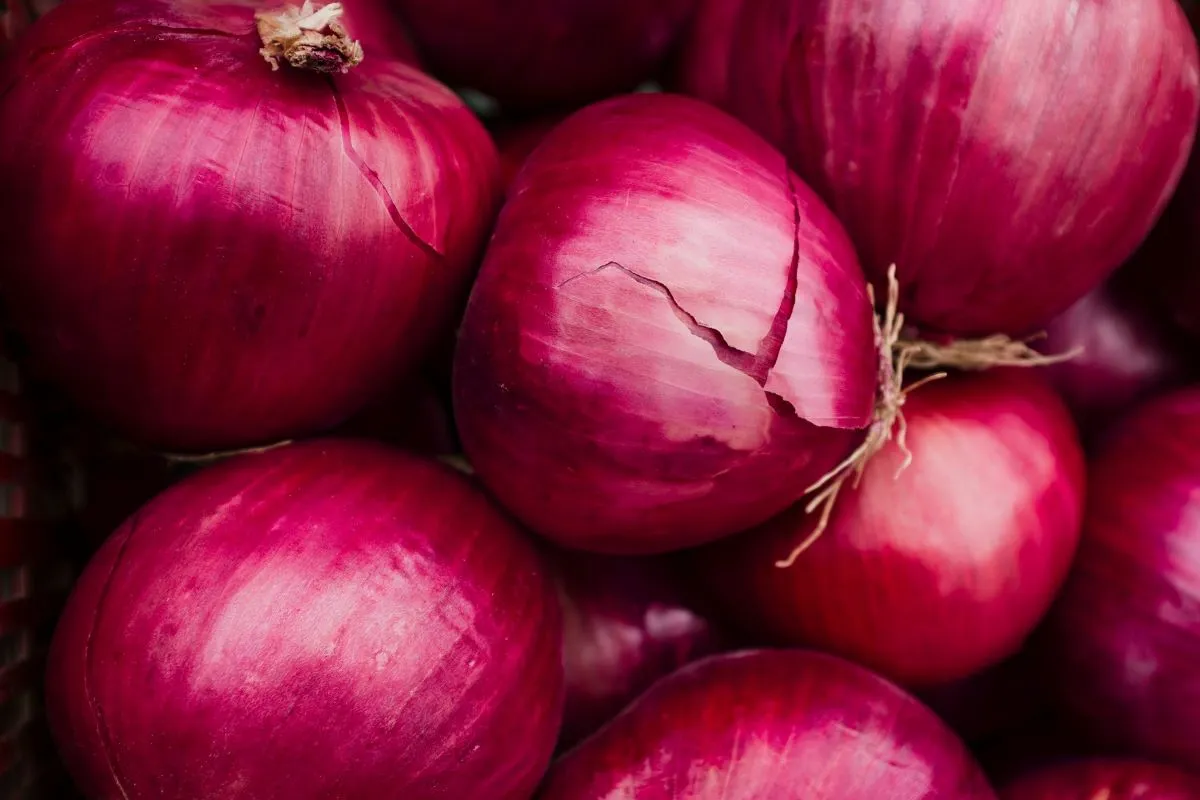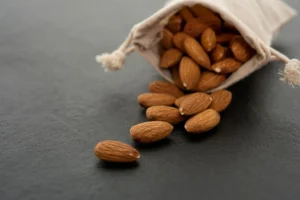Introduction
Onions are very popular all over the world. They are grown a lot and eaten in many dishes. People like their strong tastes. Onions are not just for cooking; they are also used in traditional medicine in many cultures. Some studies have examined these traditional uses to see if they are true. But there’s still not enough recent and detailed information about how onions are used in medicine. This review looks at all the research done on onions so far. It was found that onion has many different chemicals in it that can help our bodies in different ways. They can fight germs, reduce pain and swelling, and even help with diabetes and high blood pressure. But we still don’t know a lot, so more research is needed.
2. Nutrition & Health
Nutrient powerhouses, onions boast a wealth of vitamins, minerals, and antioxidants. Their sulfur compounds contribute to heart health and may reduce the risk of certain cancers. Incorporating onions into your diet can fortify your body against various ailments.
3. Varieties & Uses
The onion family offers various flavors and textures, from pungent white onions to sweet Vidalias. With their robust taste, yellow onions are culinary workhorses suitable for soups, stews, and sautés. Meanwhile, red onions lend a vibrant hue and sharp bite to salads and sandwiches.
4. Cultivation & Harvesting
Growing onions is a straightforward affair. Planted from bulbs in well-drained soil, they thrive in sunny locales. Regular watering and occasional fertilization foster healthy growth. When the foliage browns and topples, it’s time to harvest and cure the bulbs for storage.
5. Cultural Significance
Across cultures, onions hold diverse meanings. In ancient Egypt, they symbolized eternity and were buried with pharaohs. In medieval Europe, they were currency, exchanged for goods and services. Today, they remain integral to cuisines worldwide, bridging culinary traditions and cultures.
6. Practical Tips
When selecting onions, choose firm bulbs without blemishes. Store them in a cool, dry place away from potatoes to prevent sprouting. To tame their sharpness, soak sliced onions in cold water before use. And when cooking, don’t rush—slowly caramelizing onions yields rich, complex flavors.
7. Recent Research & Trends
Emerging studies illuminate onions’ potential health benefits. Compounds like quercetin and sulfur-containing compounds exhibit anti-inflammatory and antimicrobial properties. Exciting research suggests onions may even play a role in combating cancer, although more studies are needed to confirm these findings.
8. Balanced Perspective
While onions offer myriad health benefits, they’re not without drawbacks. Their potent aroma can linger on breath and hands, deterring some. Additionally, for individuals with irritable bowel syndrome or certain digestive conditions, onions may exacerbate symptoms. Moderation is key to reaping their rewards without discomfort.
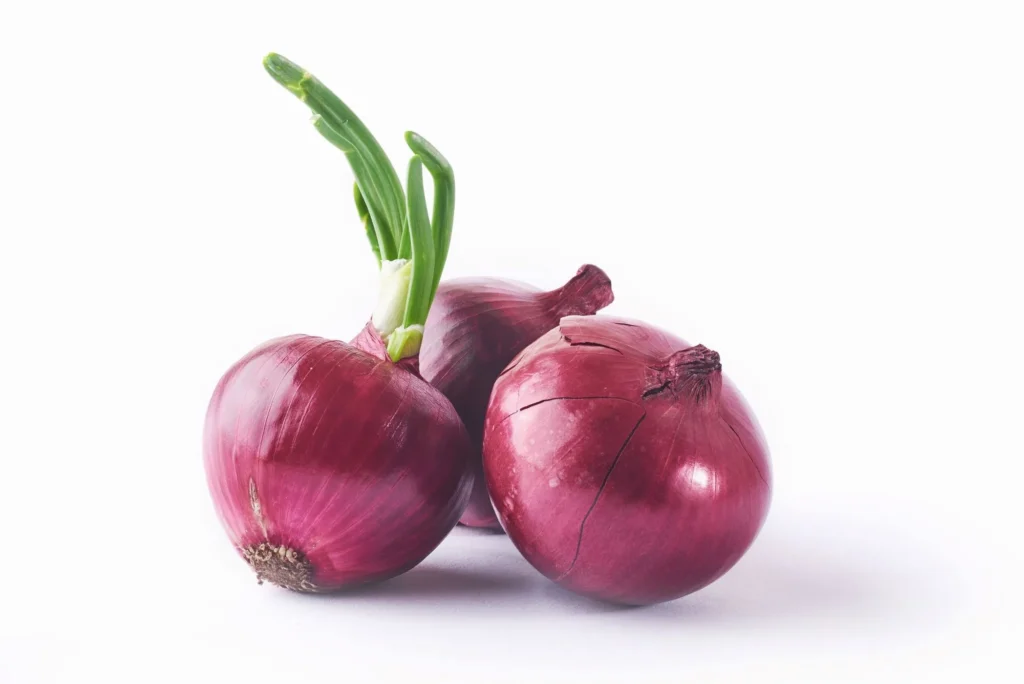
9. Sustainability & Environmental Impact
In the realm of sustainability, onions hold a favorable position. They require minimal water compared to many other crops and can be grown in a variety of climates, reducing the need for extensive irrigation and transportation. Additionally, onion skins and scraps can be composted, contributing to nutrient-rich soil for future crops.
10. Culinary Innovations & Fusion
As cooking changes, we find new ways to use onions in our food. Chefs everywhere try out different things, like making onion oils, pickling onions, and even using onions in desserts. They mix different tastes, making exciting dishes like onion bhaji tacos and sweet onion ice cream.
11. Economic Significance
Beyond their culinary allure, onions play a significant role in global economies. They are a cash crop for many regions, providing livelihoods for farmers and contributing to international trade. In some areas, onion festivals and markets celebrate the harvest season, showcasing the cultural and economic importance of this humble vegetable.
12. Future Prospects & Challenges
Looking ahead, the future of onions is bright yet fraught with challenges. Climate change threatens to disrupt growing conditions, necessitating adaptation strategies for farmers. Additionally, fluctuating market demands and trade dynamics require agile responses to ensure a sustainable onion supply chain. Embracing innovative agricultural practices and promoting biodiversity may hold the key to securing onions’ place on our plates for generations to come.
14. Recipes and Culinary Inspiration
The versatility of onions in the kitchen knows no bounds, inspiring chefs and home cooks alike to explore endless culinary possibilities. From classic French onion soup to spicy onion chutney, recipes featuring onions span cultures and cuisines. Whether raw, caramelized, or pickled, onions add depth and complexity to dishes, elevating flavors and textures with their unique profile.
French Onion Soup:
- Begin by caramelizing thinly sliced onions in butter or oil until golden brown.
- Deglaze the pan with a splash of white wine and simmer until reduced.
- Add beef or vegetable broth and simmer until the flavors meld.
- Ladle the soup into oven-safe bowls, and top with toasted baguette slices and a generous layer of grated Gruyère cheese.
- Broil until the cheese is bubbly and golden brown, then serve piping hot.
Onion Bhaji:
- Mix chickpea flour, rice flour, and spices such as cumin, coriander, and chili powder in a bowl.
- Stir in thinly sliced onions and chopped cilantro until well coated.
- Heat oil in a deep pan and drop spoonfuls of the onion mixture into the hot oil.
- Fry until golden and crisp, then drain on paper towels before serving with chutney or yogurt dip.
Caramelized Onion Tart:
- Roll out puff pastry dough and prick it with a fork.
- Spread a layer of caramelized onions over the pastry, leaving a border around the edges.
- Sprinkle with crumbled goat cheese or Gruyère and fresh thyme leaves.
- Bake until the pastry is golden brown and crisp, then slice and serve as a savory appetizer or light meal.
Pickled red onions:
- Slice the red onions thinly and place them in a glass jar.
- In a saucepan, heat equal parts vinegar and water with sugar, salt, and spices like mustard seeds or peppercorns until dissolved.
- Pour the hot brine over the onions, ensuring they are fully submerged.
- Let the onions cool to room temperature before sealing the jar and refrigerating.
- They will be ready to enjoy after a few hours and will keep for several weeks in the fridge.
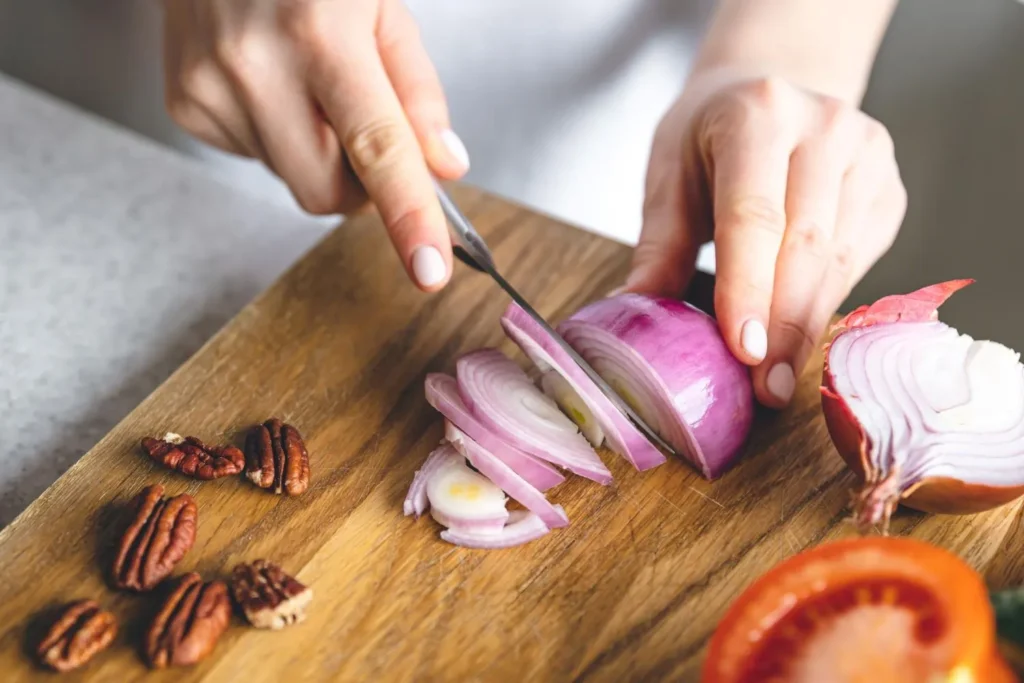
Here are some benefits of consuming raw onions:
- Boosts Immunity: Raw onions have lots of vitamin C, which helps your body fight off germs like colds and flu.
- Heart Health: Onions contain antioxidants that lower bad cholesterol, improve blood flow, and keep your heart healthy.
- Helps Digestion: The fiber in raw onions helps your stomach digest food properly and prevents problems like constipation.
- Reduces Inflammation: Certain substances in onions can reduce swelling and pain in conditions like arthritis.
- Strengthens Bones: Eating onions helps your body absorb calcium, which makes your bones stronger and prevents osteoporosis.
- Brain Power: Compounds in onions can make your brain work better, improving memory and focus.
- Fights Cancer: Onions contain substances that help prevent cancer cells from growing in your body.
- Skin Care: The antioxidants and vitamin C in onions can make your skin look better by reducing wrinkles and spots.
- Balances Blood Sugar: Onions contain chromium, which helps keep your blood sugar levels steady, reducing the risk of diabetes.
- Aids Weight Loss: Raw onions are low in calories but high in fiber, making you feel full and helping you lose weight.
Remember, while raw onions have many benefits, eating too much can cause stomach upset and bad breath. So, it’s best to enjoy them in moderation for a healthy boost!
The nutritional table for raw onions:
| Nutrient | Amount per 100g |
|---|---|
| Calories | 40 |
| Total Fat | 0.1g |
| Cholesterol | 0mg |
| Sodium | 4mg |
| Potassium | 146mg |
| Total Carbs | 9.3g |
| Dietary Fiber | 1.7g |
| Sugars | 4.2g |
| Protein | 1.1g |
| Vitamin C | 7.4mg |
| Calcium | 23mg |
| Iron | 0.2mg |
| Vitamin D | 0IU |
| Vitamin B6 | 0.1mg |
| Magnesium | 10mg |
Onion types
In three color varieties, common onions are normally available:
- Yellow or brown onions are sweet, with many cultivars bred specifically to accentuate this sweetness, such as Vidalia, Walla Walla, Cévennes, and Bermuda. They turn a rich, dark brown when caramelized and are used to add a sweet flavor to various dishes, such as French onion soup.
- Red or purple onions, known for their sharp, pungent flavor, are commonly cooked in many cuisines. They are also used raw and in grilling.
- White onions are mild in flavor; they have a golden color when cooked and a particularly sweet flavor when sautéed.
Onions are usually eaten when they grow big and round. But, you can also eat them when they are young and small. Before they become big bulbs, you can pick them early and eat them as spring onions or scallions. Sometimes, onions are picked after they start to grow into bulbs but before they are fully grown. People call these onions “summer” onions.
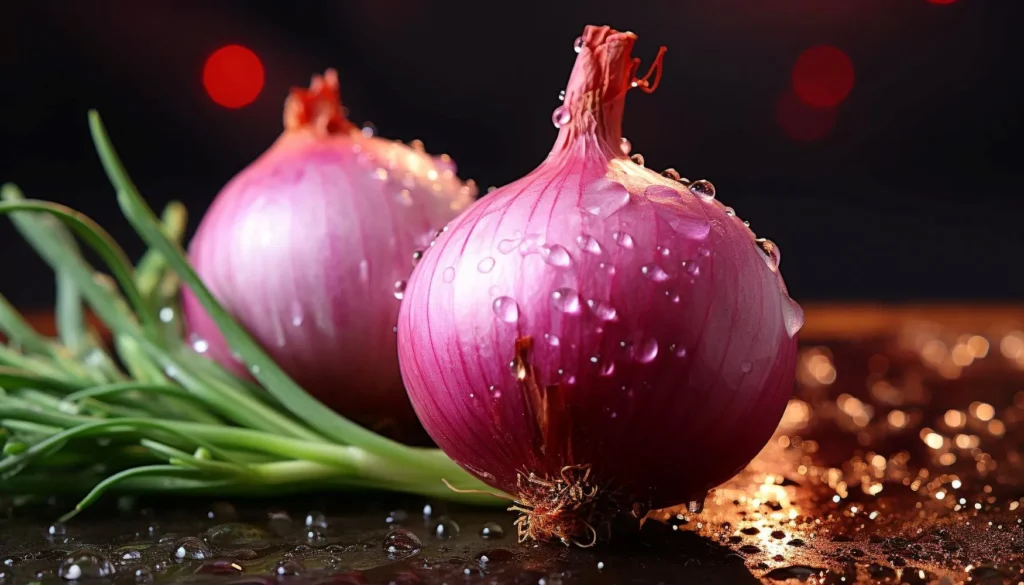
Onions, with their layers of flavor and history, enrich our lives in ways both tangible and symbolic. From ancient rituals to modern cuisines, they continue to captivate our senses and nourish our bodies. So the next time you chop an onion, take a moment to appreciate its journey—from the fertile soils of antiquity to the savory depths of your culinary creations.
